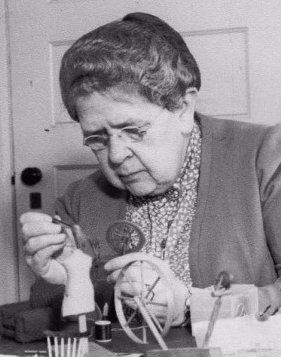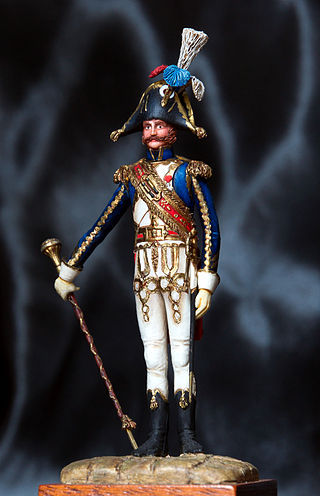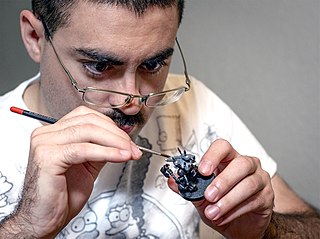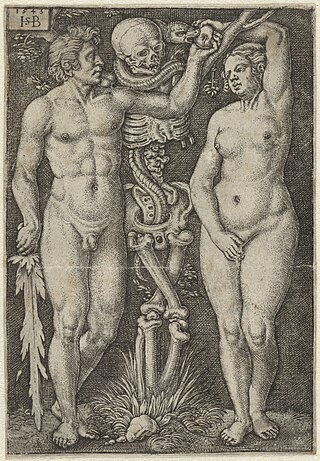Related Research Articles

A model car, or toy car, is a miniature representation of an automobile. Other miniature motor vehicles, such as trucks, buses, or even ATVs, etc. are often included in this general category. Because many miniature vehicles were originally aimed at children as playthings, there is no precise difference between a model car and a toy car, yet the word 'model' implies either assembly required or the accurate rendering of an actual vehicle at smaller scale. The kit building hobby became popular through the 1950s, while the collecting of miniatures by adults started to gain momentum around 1970. Precision-detailed miniatures made specifically for adults are a significant part of the market since the mid-1980s.

Miniature wargaming is a form of wargaming in which military units are represented by miniature physical models on a model battlefield. Miniature wargames are played using model soldiers, vehicles, and artillery on a model battlefield, with the primary appeal being recreational rather than functional. Miniature wargames are played on custom-made battlefields, often with modular terrain, and abstract scaling is used to adapt real-world ranges to the limitations of table space. The use of physical models to represent military units is in contrast to other tabletop wargames that use abstract pieces such as counters or blocks, or computer wargames which use virtual models. The primary benefit of using models is immersion, though in certain wargames the size and shape of the models can have practical consequences on how the match plays out. Models' dimensions and positioning are crucial for measuring distances during gameplay. Issues concerning scale and accuracy compromise realism too much for most serious military applications.

Frances Glessner Lee was an American forensic scientist. She was influential in developing the science of forensics in the United States. To this end, she created the Nutshell Studies of Unexplained Death, twenty true crime scene dioramas recreated in minute detail at dollhouse scale, used for training homicide investigators. Eighteen of the Nutshell Studies of Unexplained Death are still in use for teaching purposes by the Maryland Office of the Chief Medical Examiner, and the dioramas are also now considered works of art. Glessner Lee also helped to establish the Department of Legal Medicine at Harvard University, and endowed the Magrath Library of Legal Medicine there. She became the first female police captain in the United States, and is known as the "mother of forensic science".

A diorama is a replica of a scene, typically a three-dimensional model either full-sized or miniature. Sometimes it is enclosed in a glass showcase for a museum. Dioramas are often built by hobbyists as part of related hobbies such as military vehicle modeling, miniature figure modeling, or aircraft modeling.

A toy soldier is a miniature figurine that represents a soldier. The term applies to depictions of uniformed military personnel from all eras, and includes knights, cowboys, American Indians, pirates, samurai, and other subjects that involve combat-related themes. Toy soldiers vary from simple playthings to highly realistic and detailed models. The latter are of more recent development and are sometimes called model figures to distinguish them from traditional toy soldiers. Larger scale toys such as dolls and action figures may come in military uniforms, but they are not generally considered toy soldiers.

A portrait miniature is a miniature portrait painting from Renaissance art, usually executed in gouache, watercolor, or enamel. Portrait miniatures developed out of the techniques of the miniatures in illuminated manuscripts, and were popular among 16th-century elites, mainly in England and France, and spread across the rest of Europe from the middle of the 18th century, remaining highly popular until the development of daguerreotypes and photography in the mid-19th century. They were usually intimate gifts given within the family, or by hopeful males in courtship, but some rulers, such as James I of England, gave large numbers as diplomatic or political gifts. They were especially likely to be painted when a family member was going to be absent for significant periods, whether a husband or son going to war or emigrating, or a daughter getting married.
Model military vehicles are miniature versions of military vehicles. They range in size and complexity; from simplified small-scale models for wargaming, to large, super-detailed renditions of specific real-life vehicles.

A model figure is a scale model representing a human, monster or other creature. Human figures may be either a generic figure of a type, a historical personage, or a fictional character.

Figure painting, or miniature painting, is the hobby of painting miniature figures and/or model figures, either as a standalone activity or as a part of another activity that uses models, such as role-playing games, wargames, or military modeling.

Revell GmbH is an American-origin manufacturer of plastic scale models, currently based in Bünde, Germany. The original Revell company merged with Monogram in 1986, becoming "Revell-Monogram". The business operated until 2007, when American Revell was purchased by Hobbico, while the German subsidiary "Revell Plastics GmbH" had separated from the American firm in 2006 until Hobbico purchased it in 2012, bringing the two back together again under the same company umbrella. After the Hobbico demise in 2018, Quantum Capital Partners (QCP) acquired Revell.
1:144 scale is a scale used for some scale models such as micro/mini armor. 1:144 means that the dimensions of the model are 1/144 (0.00694) the dimensions of the original life-sized object; this equates to a scale of 1/2 inch per 6 feet of original dimension. For instance, an airplane 30 feet (9.14 m) in length would be a mere 2.5 inches (63.5 mm) long as a 1:144 scale model.

Monogram is an American brand and former manufacturing company of scale plastic models of cars, aircraft, spacecraft, ships, and military vehicles since the early 1950s. The company was formed by two former employees of Comet Kits, Jack Besser and Bob Reder.

Sebald Beham (1500–1550) was a German painter and printmaker, mainly known for his very small engravings. Born in Nuremberg, he spent the later part of his career in Frankfurt. He was one of the most important of the "Little Masters", the group of German artists making prints in the generation after Dürer.

John Evans Hill was an American designer of military board wargames, as well as rules for miniature wargaming. He is best known as the designer of the Avalon Hill board game Squad Leader and the American Civil War miniatures game Johnny Reb. He was inducted into the Charles Roberts Awards Hall of Fame.

The Armor Modeling and Preservation Society (AMPS) is a social club with the common interest of modeling miniature armored fighting vehicles, military model figures, ordnance, dioramas, and related equipment and promotion of historic military vehicle restoration. AMPS is an international club headquartered in the United States

The Nutshell Studies of Unexplained Death are a series of twenty intricately designed dollhouse-style dioramas created by Frances Glessner Lee (1878–1962), a pioneer in forensic science. Glessner Lee used her inheritance to establish a department of legal medicine at Harvard Medical School in 1936, and donated the first of the Nutshell Studies in 1946 for use in lectures on the subject of crime scene investigation. In 1966, the department was dissolved, and the dioramas went to the Maryland Medical Examiner's Office in Baltimore, Maryland, U.S. where they are on permanent loan and still used for forensic seminars.

The Aurora Plastics Corporation was an American toy and hobby manufacturing company. It is known primarily for its production of plastic scale models of cars, airplanes, and TV and movie figures in the 1960s. Its principal competition in modeling were various other plastic modeling firms like Revell and Monogram.

The Eaton House Group of Schools is a group of private schools, all situated in London. It is composed of the Eaton House the Manor Nursery, Eaton House the Manor Pre-Preparatory, Eaton House the Manor Preparatory, Eaton House the Manor Girls' School, Eaton House Belgravia Pre-Preparatory, and Eaton House Belgravia Preparatory. The group became a limited liability company, with Sovereign Capital becoming the majority shareholder, when principal Hilary Harper retired and sold the company in 2016. The schools are non-selective at ages 3 and 4. In June 2021, Eaton House Schools became part of the Dukes Education group of schools.
Bruce "Duke" Seifried was a maker of Miniature models for games.

Miniature Self-Portrait is the smaller of two known miniature self-portraits by skilled portraitist Sofonisba Anguissola to survive. Painted around 1556, this small oil on parchment on cardboard is set in a metal frame with a scroll surmount. The choice of format is based on Anguissola's knowledge of the works of the celebrated Italian Renaissance miniaturist Giulio Clovio (1498-1578), as well as virtuous self-fashioning, and the Renaissance taste for puzzles. The painting is in the permanent collection of the Museum of Fine Arts, in Boston.
References
- ↑ "The world of miniatures loses a towering giant". Military Miniature Society of Illinois. Retrieved 3 August 2015.
- 1 2 3 4 Sheperd Paine: The Life and Work of a Master Modeler and Military Historian by Jim DeRogatis
- ↑ Derogatis, Jim (2008). Sheperd Paine: The Life and Work of a Master Modeler and Military Historian. Schiffer Publishing, Limited. ISBN 978-0764329296.
- ↑ "AMMS Brisbane News" (PDF). Australian Military Modelling Society. 2015-09-05. Retrieved 2017-09-10.
- ↑ "Pelikan Droppings" (PDF). Pelikan Model Club. September 2015. Retrieved 2017-09-10.
- 1 2 3 sheperdpaine.com
- ↑ DeRogatis, Jim. Sheperd Paine: The Life and Work of a Master Modeler and Military Historian. Atglen, PA: Schiffer Military History, 2008. ISBN 9780764329296 OCLC 369289816
- ↑ Kates, Joan Giangrasse (7 August 2015). "Howard 'Shep' Paine, giant in world of art miniatures, dies". chicagotribune.com.
- ↑ "Historical Perspective," The Chicago Sun-Times, Oct. 9, 2005